Content
Rose Louise Bagnet is an ornamental plant belonging to the Canadian park group. The variety has gained wide popularity among gardeners and is actively used in landscape design. The rose has a unique structure and color of flowers. The plant is resistant to adverse factors, therefore it is suitable for growing in almost any region of Russia.
Breeding history
Louise Bagnet was developed in Canada in 1960. The originator is the renowned breeder Georg Bagnet. He has developed many Canadian varieties that are sought after by gardeners around the world.
Roses by Louise Bagnet were originally developed for the purpose of planting in open areas under unfavorable growing conditions. The resulting variety turned out to be the most frost-resistant among the Canadian park group. During breeding works, wild rose hips were used, which explains the high resistance to unfavorable factors.
Description of Canadian park rose Louise Bagnet and characteristics
The plant is a shrub up to 90 cm high. Roses Louise Bagnet have strong, not very elastic stems. A bush of medium branching. The largest number of shoots is formed in the upper part of the crown.
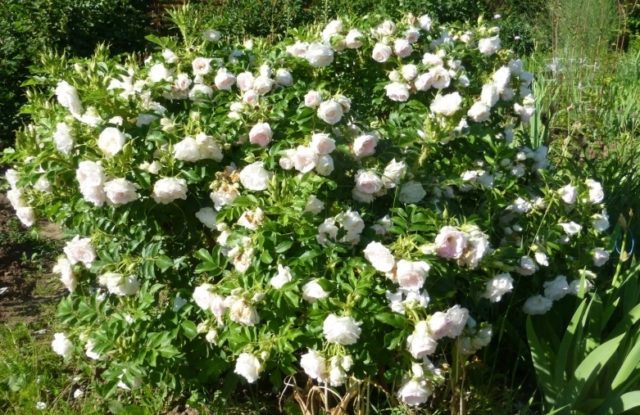
The diameter of the rose reaches 150 cm
Shoots with light green bark, covered with a lot of leaves. Large spines are practically absent. They are matte small, 5-7 cm long. The shape of the leaves is ovoid, with small notches along the edges of the plates. Veins are dark, noticeable
The Louise Bagnet variety has unique decorative properties. Buds appear on new shoots in late May and early June. It blooms twice, with a short break that lasts 2-3 weeks.
At the beginning, bright cherry buds form. Gradually, white petals with a slight green tint appear on them. Blooming flowers quickly crumble - in 2-3 days. On the stems, new buds open almost immediately, which is why the bush remains bright.
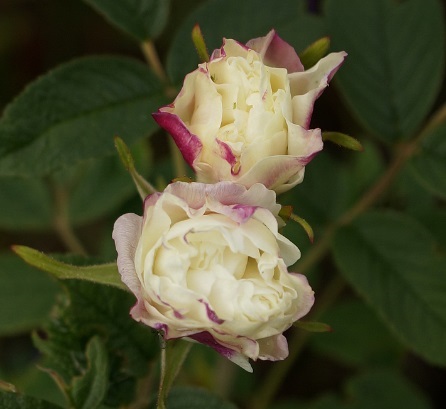
2-3 flowers appear on each shoot
The first wave lasts about a month and takes place in June. After a short break, the second stage of flowering begins. New buds appear with white and lilac petals.
The flowers of the rose Louise Bagnet are cupped. They are medium-sized. Each bud consists of 30-40 petals.
The aroma of the plant is mild, but persistent. The smell resembles wild rose flowers.
The Louise Bagnet variety is characterized by high winter hardiness. The plant tolerates frost down to -40 degrees without negatively affecting the condition of the bush and subsequent flowering. In almost all climatic zones, the variety is not covered for the winter due to the lack of the need for such an event.
The plant is resistant to fungal infections. Roses rarely suffer from powdery mildew and black spot. This usually happens due to a violation of the rules of care.
In the later stages of flowering, the buds can be damaged by rain. The rest of the variety is considered to be resistant to atmospheric precipitation.
Roses Louise Bagnet normally tolerate short-term drought. The plant does not need constant watering.Abundant replenishment is required only on the hottest summer days.
Advantages and disadvantages
Roses Louise Bagnet are highly regarded by gardeners for their decorative qualities. This is one of the few two-tone varieties, characterized by unpretentiousness and ease of care.
Main advantages:
- compactness;
- prolonged double flowering throughout the summer;
- disease resistance;
- frost resistance;
- high growth rate of stems.
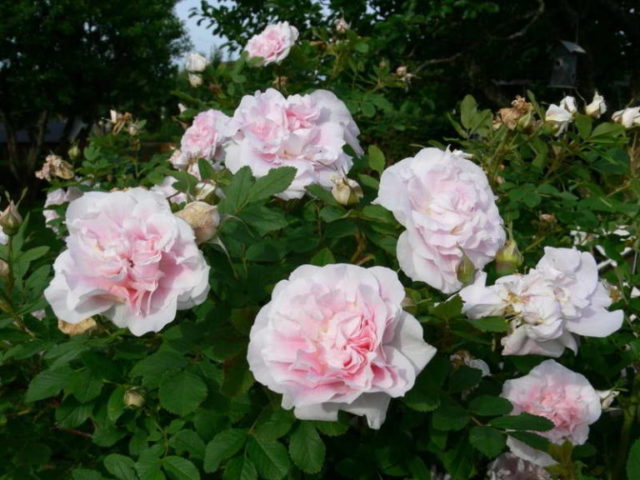
Roses Louise Bagnet grow well in the sun and in partial shade
The disadvantage of the variety is the average drought resistance. A significant disadvantage is also the rapid wilting of flowers.
Reproduction methods
Representatives of the Canadian park group tolerate bush division well. This procedure is carried out in early spring or early autumn. As a planting material, a trimmed shoot with a root and several buds is separated from the mother bush. They are planted in a permanent place or pre-rooted in containers with soil.
Bushes also propagate well by cuttings. Planting material is harvested in the spring, during the active growing season of the bush.

Cuttings with several buds and leaves are rooted in a nutritious substrate
Planting is usually carried out in the fall. Rooted cuttings are transferred to open ground in September, where they have time to adapt to new conditions and adapt to the cold.
Growing and care
Rosa Louise Bagnet is planted in well-lit or partially shaded areas. Planting in the shade is not recommended, as the bush will grow slowly and bloom worse.
The site is pre-dug up, compost or other organic fertilizer is applied. Planting is usually done in early April, but can also be done in September.
Roses Louise Bagnet grows best in loamy soils with neutral acidity - from 5.6 to 6.5 pH. The place must be well drained to eliminate the risk of water stagnation in the roots.
It is best to place the Louise Bagnet rose in areas protected from strong winds. This allows you to increase the flowering period and prevent premature bud fall.
A hole is dug for a seedling, 60 cm deep and wide. The drainage layer should be at least 15 cm. The hole is covered with a soil mixture of turf and garden soil, peat and humus. The rose is planted with a root collar deepening 3-4 cm. The topsoil is compacted, watered and mulched with bark or straw.
Follow-up care includes the following activities:
- Watering as the soil dries out, 1-2 times a week.
- Fertilizing the bush with nitrogen and potassium during the budding period and during flowering every 3 weeks.
- Removing weeds around the plant.
- Loosening and mulching the soil 2-3 times a month, as it compresses.
- Pruning bushes to form a crown.
Preparation for winter involves the removal of faded buds. Cut off the shoots of the plant only if they are damaged. Healthy stems can be shortened by 2-3 buds.
It is recommended to cover the lower part of the stems with loose soil and mulch with a thick layer of bark, sawdust or straw. Aerial shoots do not cover for the winter.
Pests and diseases
Under the influence of unfavorable factors, the rose bushes Louise Bagnet can infect insects. Most often this occurs in summer, in dry weather, and with prolonged disruption of air circulation.
Common pests include:
- thrips;
- aphid;
- leaf rollers;
- rose cicada;
- slobbering penny.
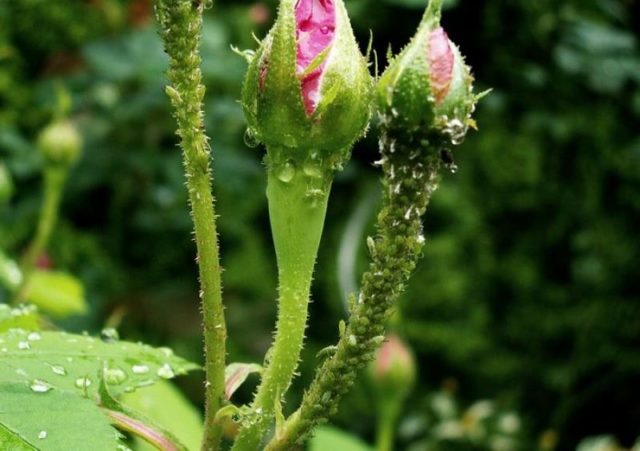
The appearance of pests negatively affects the external qualities of the bushes.
If insects are detected, the bush must be treated with an insecticide. Alternatively, use an infusion of calendula, garlic, or soapy water. The bush is processed 3-4 times with an interval of 1 week.
The Louise Bagnet variety is resistant to fungal diseases. The bushes are sprayed for preventive purposes once - in the spring before the buds appear.
Application in landscape design
The plant is used for single and group plantings. With their help, they create elongated rose gardens and flower beds. The variety is well suited for planting next to low-growing ornamental plants that show shade tolerance.
In group plantings, the bushes are placed at a distance of 50 cm between each. Louise Bagnet is best combined with other varieties from the Canadian park group.
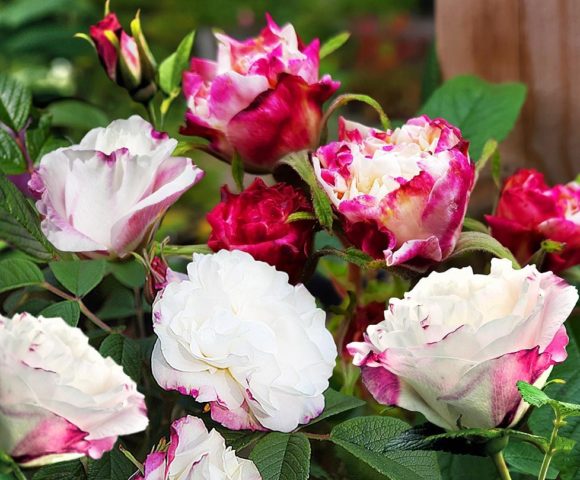
Cut roses are used for bouquets
Louise Bagnet can be planted in open areas. Also, the bushes are placed near garden buildings, gazebos, near verandas, terraces, walls of the house.
Conclusion
Rose Louise Bagnet is a plant with unique decorative qualities. The variety is highly resistant to frost and disease. The bush is undemanding to care for and is great for beginner gardeners. Due to its characteristics, the plant is grown for decorative purposes in regions with any climatic conditions.








